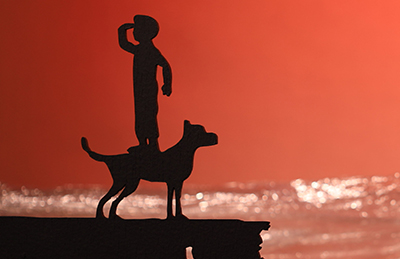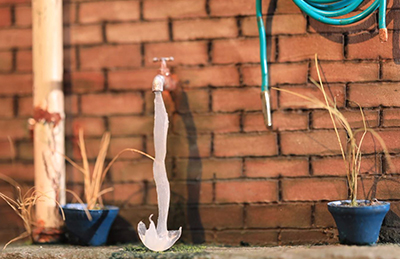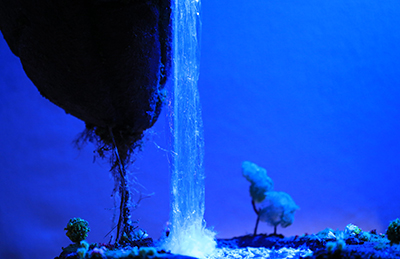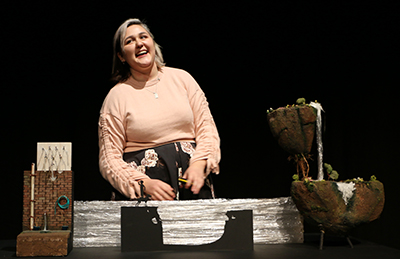NIDA BFA Properties and Objects students presented their major third-year works exploring a huge variety of angles, materials and uses. The works ranged from ancient swords and effects, to collapsible props, fruit costumes and the use of miniature water in stop-motion film.

Photo: Brittany Warboys’ silhouette cutout with water.
NIDA BFA Properties and Objects students presented their major third-year works exploring a huge variety of angles, materials and uses. The works ranged from ancient swords and effects, to collapsible props, fruit costumes and the use of miniature water in stop-motion film.
Brittany Worboys, from the Sunshine Coast of Queensland, says that she grew up watching stop-motion films like Chicken Run, Wallace and Gromit and Coraline and came to NIDA fresh out of high school with a dream of pursuing a career in the stop-motion industry.
‘I love tiny things and have always obsessed over anything miniature. I thank my Grandma for that as she had a collection of tiny pots, vases, and cars that I played with as a child. I believe she set me on this tiny path,’ she said.
Brittany chose a miniature water project for her masterwork after being inspired by Wes Anderson films Fantastic Mr Fox and The Isleof Dogs.


Above: Brittany Warboys’ miniature tap and water (above) and (below) waterfall cascade.

Above: Brittany Warboys at the Properties and Objects Masterworks Presentation
How do you create real life water effects in stop-motion animation films? ‘Water is something most animatorsin this fieldwill tell you is something they want to steer clear of,’ said Brittany.
‘Wes Anderson didn’t use computer graphics to create his natural elementslike smoke, fire, and water,’ said Brittany. ‘They were all handcrafted, each one was moved painstakingly by one person or a team of people to create movement.’
‘It’sdifficult to get it to do what you want and still look like realwater. Most sources would saythat they just use CGI(computer generated imagery) now. I wanted to explore the practical and had to delve deeper into research. There’s a lot of hair gel!’
‘What I’vealways found fascinatingabout stop-motion animation is this sense of life, thisrealness that people bring to what are essentially dolls. I love these tiny worlds that seem so real. What makes them real to me is the naturalist elements, like water. How do they make it tiny, how do they make it move?’
‘I’m used to documenting my work but trying to make a static object seem fluid was hard. Every shot is crucialso it’dtake me a good hour to set up the camera, the software (a stop-motionanimation program used in the industry called Dragonframe), the lights and the models. Any slight knock and I’d have to start again. Which often meant 130 shots became worthless. As frustrating as that was I grew a deeper appreciation for the art of animation as well as a steadier hand.’
Brittany’s dream job is to become part of the film industry and she has high hopes of getting into the stop-motion scene.
Apply for NIDA’s Bachelor of Fine Arts (Properties and Objects) course in 2019 here.
